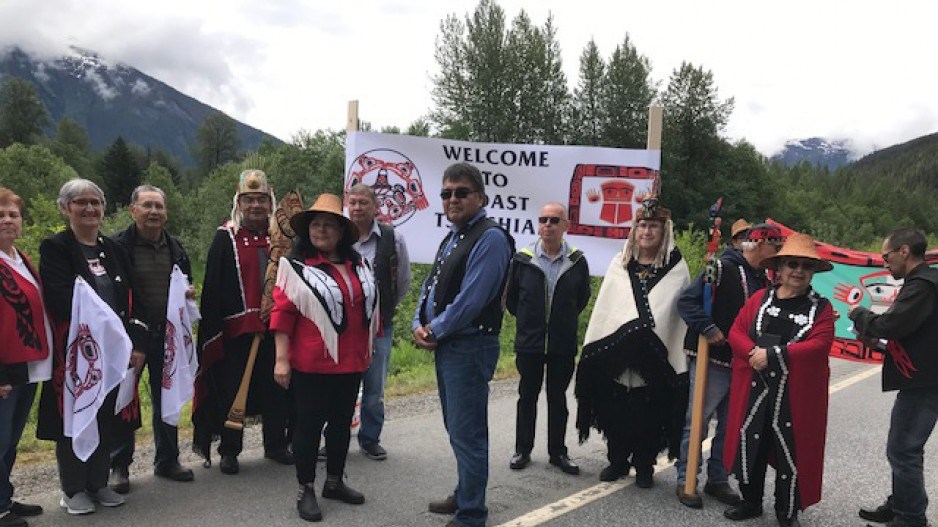Members of the Coast Tsimshian tribes set up a three-hour blockade today on Highway 16, between Terrace and Prince Rupert, to protest the sale of Crown land to the Nisga’a First Nation.
The tribes have been trying to get the B.C. government to reconsider the sale of 22,100 hectares of land known as the Nasoga Gulf lands – to which they lay claim – to the Nisga’a First Nation.
But the province is refusing to hear their concerns, they say, so on Friday, June 7, members of nine Coast Tsimshian tribes set up an information blockade on a reserve between Terrace and Prince Rupert on Highway 16, and stopped motorists to hand out information.
“We’ve had several meetings with lower level people in the province trying to get meetings with appropriate ministers and not been successful,” John Helin, who is the elected mayor of the Lax Kw’alaams Band, told Business in Vancouver.
Unlike the Nisga’a, none of the Tsimshian tribes have treaty, so any title claims they assert may need to be confirmed by the courts – a process that can take years, or decades.
The Nisga’a were the first indigenous group in B.C. to sign a modern treaty, which included a substantial land parcel. Helin doesn’t understand why the province is now offering them more land.
“From what I understand, once you sign a treaty, that you’re giving up your rights and title to other land that you may have claimed in the past,” Helin said.
Helin said the land offer was originally part of the Petronas Pacific NorthWest LNG proposal. The Tsimshian learned of the offer in 2016, and opposed it.
In return for Nisga’a support for a pipeline that could cut through Nisga’a treaty land, the Nisga’a negotiated access to some of the gas, and had planned to develop their own industry using some of that gas.
But Petronas pulled the plug on the Pacific NorthWest LNG project in 2017, so Helin doesn’t understand why the land is still being offered.
“We disagreed with it right from the beginning,” Helin said. “Of course, the project didn’t go ahead, so we thought that the proposal just died, until it surfaced recently.”
While the PNW LNG project may be dead, the pipeline that was associated with it isn’t.
Last year, TC Energy Corp. (TSX:TRP) – formerly TransCanada Corp. – announced plans to proceed with the Prince Rupert Gas Transmission pipeline, despite Petronas pulling the plug on its LNG plant in Prince Rupert that was originally associated with it.
In April, TC Energy received approval from the province to extend its environmental certificate. The company has said there are other potential LNG developers with plans for LNG in Prince Rupert.
The Tsimshian say the land in question is part of their traditional territory, and have submitted a report to the government to prove it. They hired Andrew Martindale, an anthropological archaeologist at the University of BC, to produce a report providing evidence of their claim.
But the Nisga’a say that the land in question is covered by their treaty – though not in title – and is contiguous with Nisga’a treaty land.
“The area covered by the transaction has been part of the exclusive territory of the Nisga’a Nation since time immemorial, and is already included in areas where the Nisga’a Nation has constitutionally protected rights and co-management responsibilities under BC’s first modern treaty, the Nisga’a Final Agreement,” the Nisga’a Lisms Government said in a press release.
“Over the last three years, Nisga’a Lisims Government has made repeated attempts to meet with our neighbours, Lax Kw’alaams and Metlakatla, and discuss this land purchase, but our efforts were rebuffed,” Eva Clayton, President of Nisga’a Lisims Government, said in the release.
“Essentially, we are purchasing our own land at fair market value—lands that are already included in our Treaty areas—so that we can pursue economic development to benefit the Nisga’a Nation and all British Columbians.”
A spokesperson for the Ministry of Indigenous Relations & Reconciliation was not immediately available for comment on the dispute.




